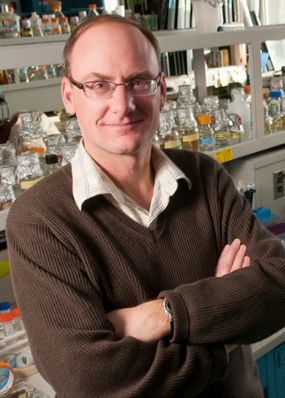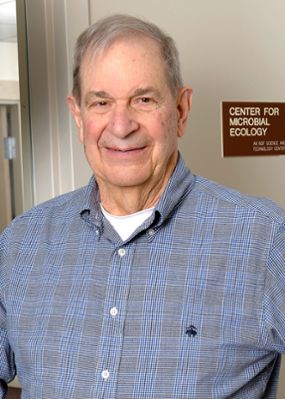NatSci faculty recognized among the world's most highly cited researchers
Three Michigan State University College of Natural Science (NatSci) researchers are among nine MSU faculty members recognized in the 2021 Highly Cited Researchers list, an annual compilation of the global leaders in scientific influence by Clarivate Analytics.
The list, now in its eighth year, honors researchers who “demonstrated significant and broad influence reflected in their publication of multiple highly cited papers over the last decade” from 21 different fields of study. These pioneers represent the most influential scholars in their respective fields and have frequently published multiple paper – cited by their peers – that rank in the top one percent of citations for their field and year in the Web of Science.
The papers surveyed were the most recent papers available to Clarivate Analytics – those published and cited from 2010 to 2020 and which, at the end of 2020, ranked in the top one percent by citations for their ESI (Essential Science Indicators) field and year. Of the world's population of scientists and social scientists, Highly Cited Researchers are one in 1,000.
NatSci scientists making the 2021 Highly Cited Researchers list are:
Christoph Benning

Christoph Benning, University Distinguished Professor and MSU Foundation Professor in the Department of Biochemistry and Molecular Biology, and director of the MSU-DOE Plant Research Laboratory (PRL), makes his third appearance on this list.
Benning is a recognized leader in research on lipid metabolism in photosynthetic organisms, particularly the assembly and maintenance of the photosynthetic membrane in plants and algae, which contains a unique set of polar lipids. His lab studies the biosynthesis and movement of lipids of the photosynthetic membrane. The specific functions of these lipids in photosynthesis, especially during dynamic conditions, is investigated by applying state-of-the-art phenotyping to Arabidopsis and Chlamydomonas lipid mutants.
“It is an honor to be included again in this year’s list of Highly Cited Researchers,” Benning said. “This would not have been possible without my coauthors, the students and scientists in my laboratory, and my collaborators at MSU and other institutions. Many significant scientific discoveries these days are made by interdisciplinary teams, and I am grateful for everyone’s contributions to our publications. Interdisciplinary and collaborative work is also a hallmark of research done at the MSU-DOE Plant Research Laboratory where I work.”
Gregg A. Howe

Gregg Howe, University Distinguished Professor and MSU Foundation Professor in the Department of Biochemistry and Molecular Biology and the MSU-DOE Plant Research Laboratory, and a National Academy of Science member, has been recognized on this list for all eight years.
Research in Howe’s lab aims to understand how plants respond to insect, herbivory and other forms of wound stress, using tomato and Arabidopsis as experimental model systems for three related areas of investigation: elucidating the mechanism of synthesis and action of the plant hormone jasmonate, studying how jasmonate-regulated defensive compounds thwart insect attack, and the development and metabolic function of glandular trichomes in tomato. These projects provide training in several areas of modern plant biology, including analysis of protein–protein and receptor–hormone interactions, transcriptional networks, plant development, genetics of plant-insect interactions, protein biochemistry/proteomics, metabolism and metabolomics, and crop improvement for insect resistance. Howe was elected to the National Academy of Sciences (NAS) in 2020 in recognition of his distinguished and continuing achievements in original research.
“It’s nice to see that our work continues to be highly cited within the field of plant science,” Howe said. “This recognition reflects the talents of many team members and collaborators who contributed to the work over many years, as well as the supportive research environment here at MSU.”
James Tiedje

James Tiedje, University Distinguished Professor Emeritus and former director of the Center for Microbial Ecology, is appearing on the list for the fifth time. Tiedje, whose tenure home is the CANR’s Department of Plant, Soil, and Microbial Sciences, also held a joint appointment in NatSci’s Department of Microbiology and Molecular Genetics.
Research in Tiedje’s lab aims to understand the ecology, physiology and biochemistry of microbial processes important in nature and of value to industry. While it is common to study a microbe in laboratory culture, understanding its competitiveness, vegetation and community interactions usually determines its success in its habitat, whether that be soil, lakes, or a bioprocessing reactor. This theme is studied under three research areas: 1. discovering, understanding and developing new bioconversion reactions by anaerobes, especially for destruction of hazardous wastes; 2. the ecology, physiology and biochemistry of denitrification, which converts NO3 to N2, and is thus a major route of loss of the nutrient most limiting to plant growth; and 3. the fate and impact of genetically engineered microbes so that their success or risk in nature can be better predicted.
“As scientists, our goal is to discover and to communicate new knowledge; some of that knowledge becomes building blocks to greater basic insight while other knowledge contributes directly to addressing practical problems,” Tiedje said. “Citations mean that one’s contributions to knowledge are recognized and being used, hence having an impact. I’m pleased to be recognized for high citations for five consecutive years, indicative that my research is being used. It is perhaps the best evidence of science investment proving real value. For me, my team, MSU and the funders, this a very high ‘final grade.’”
Other MSU researchers recognized on this year’s list are Rufus Isaacs, professor, Department of Entomology, College of Agriculture and Natural Resources (CANR); Russell Johnson, Department of Management, Broad College of Business; Aaron McCright, Department of Sociology, Lyman Briggs College, and Environmental Science and Policy Program, College of Social Science; Mohmoudi Morteza, Department of Radiology, Precision Health Program; Tomas G. Hult, Department of Marketing, Broad College of Business; and Jianguo “Jack” Liu, Center for Systems Integration and Sustainability, Department of Fisheries and Wildlife, CANR.
A total of 6,602 researchers were named Highly Cited Researchers in 2021 – 3,774 in specific fields and 2,828 for cross-field performance. The number of researchers selected in each field is based on the square root of the population of authors listed on the field's highly cited papers. The number of those with cross-field influence is determined by finding those who have influence equivalent to those identified in the 21 fields.
Banner image: Requirements for earning a place in the 2021 Highly Cited Researchers list, an annual compilation of the global leaders in scientific influence by Clarivate Analytics list include publication of multiple highly cited papers from 2010 to 2020 and ranking in the top one percent of citations in their fields.